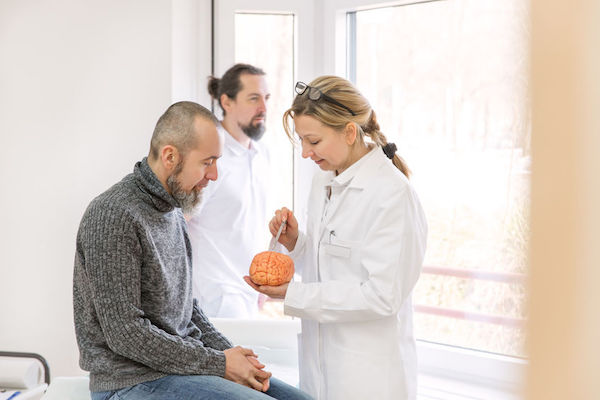An aneurysm is an enlarged portion of a blood vessel that can rupture and be fatal.

An aneurysm is caused by a weakness in the blood vessel wall, usually where it branches. As blood passes through the weakened blood vessel, the blood pressure causes a small area to bulge outwards.
Aneurysms can develop in any blood vessel anywhere in the body, but the most common are the abdominal aorta (the artery that transports blood away from the heart to the rest of the body) and the brain. There are other types of aneurysm.
It’s important to diagnose an aneurysm as soon as possible, as they become larger over time, resulting in a risk of rupture, which can be dangerous and lead to death.
Causes and risk factors include high blood pressure (hypertension), a family history of brain aneurysms and smoking.
What are its symptoms?
Symptoms of aneurysm are rare and difficult to detect. They also depend on the type and location of the aneurysm.
An aneurysm in the brain will only cause rupture symptoms (subarachnoid haemorrhage). Bleeding caused by the ruptured aneurysm can cause extensive brain damage and symptoms such as:
- A painful headache
- Stiff neck
- Back pain
- Nausea
- Vomiting
- Blurred vision
- Drooping eyelid
- Loss of consciousness
Most abdominal aortic aneurysms (AAAs) develop slowly over years. They often don't cause signs or symptoms unless they rupture. However, symptoms can include:
- A throbbing feeling in the stomach and abdomen
- A deep pain in the abdomen and back
- Steady pain in your abdomen that lasts for hours or days
How is it diagnosed?
In a typical aneurysm diagnosis, your doctor will question you about your symptoms, medical history and about possible incidences of aneurysms in your family.
He/she will then perform a physical examination, including listening to your heart, checking your blood pressure, listening to the arteries in your neck and feeling your abdomen for a mass.
If your doctor suspects that you have an aneurysm in your aorta, an ultrasound test may be performed to pinpoint and measure it. If an aneurysm in the chest is suspected, a CT scan may be recommended to measure it more closely.
If your doctor suspects an aneurysm in the brain, a CT scan or angiogram (an invasive test) will be recommended. An MRI can also be recommended in the assessment of the aorta or blood vessels in the brain.
What are your treatment options?
Treatment depends on the size, type and location of an aneurysm.
For inoperable aneurysms, you may be prescribed drugs that lower your blood pressure or reduce the force of your heart’s contractions, so minimising rupture risk.
For an operable aneurysm, your doctor may first try drug therapy and then monitor it with periodic testing to track the aneurysm's growth.
If an aneurysm has become dangerously enlarged, you may need an operation. A surgeon can insert a clip that cuts off blood flow to the affected area. An aneurysm may also be removed and the section of artery replaced with a synthetic graft.
Can it be prevented?
It is not possible to prevent an aneurysm. Your best strategy is to know if you are at risk and take steps towards prevention. This includes avoiding activities that could damage your blood vessels, such as:
- Smoking
- A high-fat diet
- Lack of exercise
- Being overweight or obese
The most important thing you can do to prevent aneurysms is to control your blood pressure.
People at high risk of aneurysms may benefit from early routine screenings. Your doctor may recommend this if you're:
- A man between the ages of 65 and 75 who has smoked
- A man or woman between the ages of 65 and 75 who has a family history of aneurysms
If you’re at risk, but not in one of these high-risk groups, ask your doctor whether screening will benefit you.
IMAGE CREDIT: 123rf.com
